Supercharge Your Rip Fence
Smart base supports a host of essential tablesaw accessories.

Synopsis: When Bob Van Dyke needed an auxiliary rip fence that he could easily attach and remove without damaging the tablesaw’s main fence or sacrificing accuracy, he came up with this supercharged base, which is both practical and versatile. The base is made from 3⁄4-in. Baltic-birch plywood, fastened into an H-shape that straddles the saw’s rip fence. A pair of toggle clamps applies pressure to the back of the base, drawing the front tightly into place. After the base is built, it’s a simple matter to equip it with the add-on fences you need for tasks such as cutting rabbets, tenons, raised panels, and other workpieces.
Your tablesaw’s rip fence is an integral part of the tool. It performs the basic task of guiding the workpiece parallel to the blade. without it, you can’t rip wood safely or accurately.
But that’s just the beginning of its usefulness. It is also common practice to clamp any number of jigs and auxiliary fences to the rip fence for specific jobs like cutting a rabbet in the edge of a board or a bevel on a raised-panel door. The problem with this is the clamping and the low height of the fence. Put the clamps low and they hinder the workpiece sliding by; too high, and the extra fence won’t stay plumb.
I decided it was time to make something better, so I borrowed an idea from a special fence I had made years ago. what I needed was an auxiliary fence that I could easily attach and remove without damaging the main fence or sacrificing accuracy. I wanted to do it without putting clamps in the way of the work, and I wanted to make it easy to attach a variety of useful jigs.
No one sets up shop just to make jigs, but I think you’ll find it’s worth the time to build the base and the add-ons I describe here. You will probably find even more uses as you put the system to work.
This base is the key
In terms of usefulness, this auxiliary fence base gets the prize. By adding special-purpose fences, common tasks such as cutting rabbets and tenons and panel-raising are all greatly simplified. The base is made from 3 ⁄4-in. Baltic-birch plywood, fastened into an H-shape that straddles the saw’s rip fence. A pair of toggle clamps applies pressure to the back of the base, drawing the front tightly into place. The base doesn’t need to fit the width of your rip fence precisely because the clamps pull it into position.
Start by creating the bridge from two lengths of plywood. Face-glue and screw or nail the pieces together and then rip the bridge to width. Make sure the long edges are parallel: They will be glued into dadoes in the backs of the two uprights to form the H. Cut the dadoes in the uprights using a 3⁄4-in. dado cutter at the tablesaw. Take multiple passes to sneak up on the fit.
Before gluing up, use a Forstner bit to drill a pair of clearance holes for the toggle clamps in the rear upright. Replace the adjustment bolts on the toggle clamps with ones that are long enough to reach through the plywood upright to the rip fence. A small rubber crutch tip from the hardware store cushions the bolt head that bears against the fence face.
On the front upright, drill five holes for T-nuts: three evenly spaced across the top and two along the bottom, each far enough from the center to avoid touching the blade. The T-nuts provide an easy way of screwing the special-purpose fences to the base. Make a template of this bolt-hole layout so you can transfer it accurately when making the attachment fences.
The value of the base lies in the variety of special-purpose fences you can add to it.
A sacrificial fence for rabbeting
This fence is very simple—just a flat piece of 3⁄4-in. MDF drilled with counterbored holes. But you will use it all the time.
I make most of the special-purpose fences from 3⁄4-in. MDF because it stays flat and its smooth surface lets workpieces slide across it easily. It also costs less than the alternatives. While I was set up to make this fence, I cut and drilled a number of extras so they would be ready when needed.
With this fence, it’s easy to cut rabbets to a custom width. Partially burying a wide dado cutter in it lets you adjust the cut’s width simply by moving the rip fence. I also use this fence often as a stop when cutting tenons with a dado set.
To bury the cutter, raise the spinning blade into the MDF fence to the height you need. Then turn off the saw and fine-tune the blade height and the fence location. Don’t raise the blade any higher than necessary because a fence with a large cutout won’t work for smaller rabbets and stub tenons, where the workpiece would dive into the gap between the cutout and the blade.
A tall fence for panels
A taller MDF or melamine fence, this one 8 in. wide, provides extra support for tall work. It is great for cutting bevels on the face of a raised panel or drawer bottom. A push block a few inches above the blade gives you a solid and safe grip on the workpiece as it travels past the blade. For the greatest support, let your right hand ride the top of the fence as it grips the workpiece.
The fence and sliding backer block support the narrow workpiece, keeping it perfectly vertical. The sliding block straddles the upper edge of the tall fence, which is built out with an attached runner strip. The top of the slider actually wraps around the runner strip—an important safety feature that prevents the fixture (and the user’s hand) from diving in toward the blade.
Problem
The clamps on this simple rabbeting fence are set high enough to let the workpiece travel freely, but this setup pulls the fence out of plumb, kicking it outward at the bottom edge.
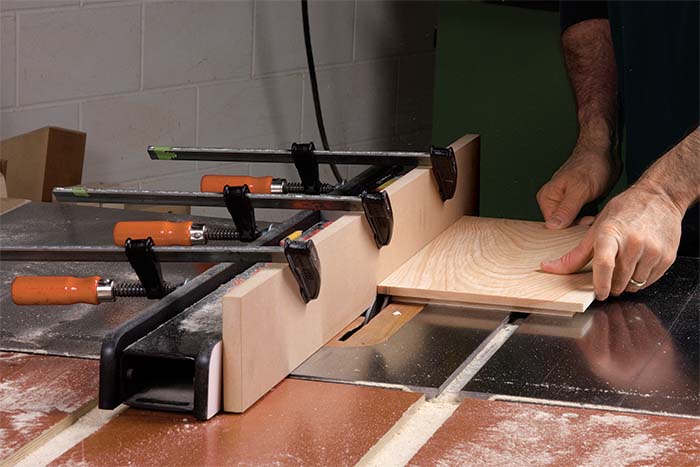
Solution
Clamp this fixture over the tablesaw’s rip fence to create a base for a variety of useful fences. The toggle clamps secure the base from the back, leaving a clear path for the workpiece.
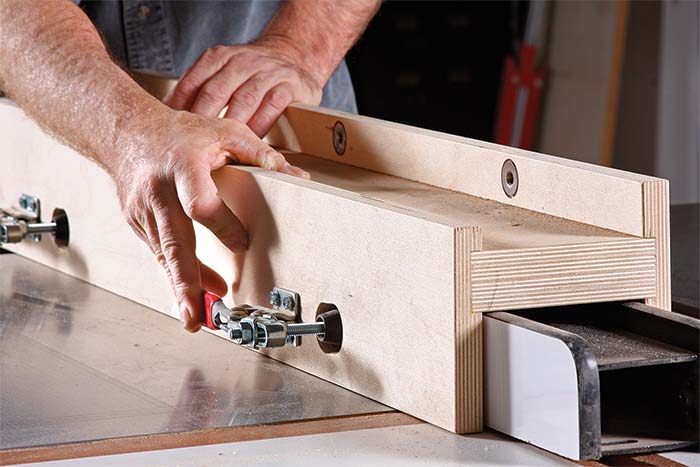
Rabbets
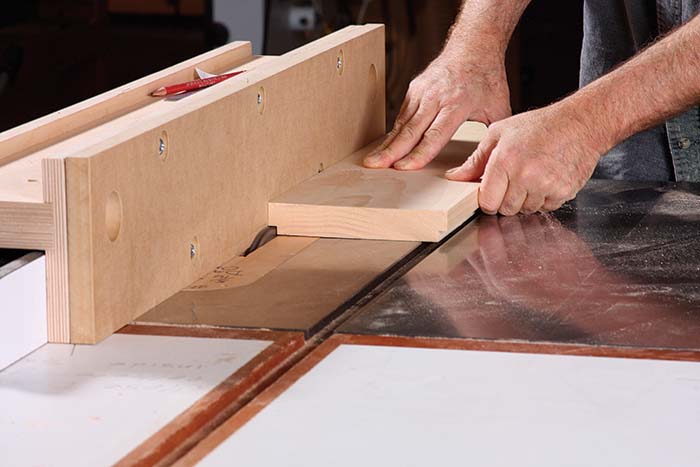
Panels and Tenons
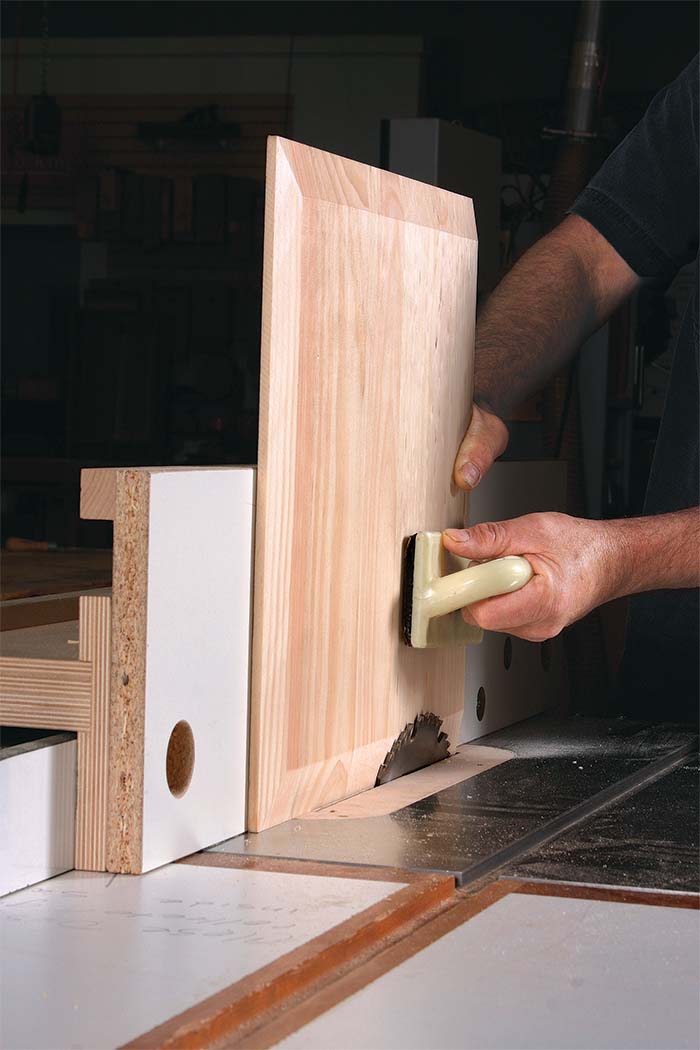 |
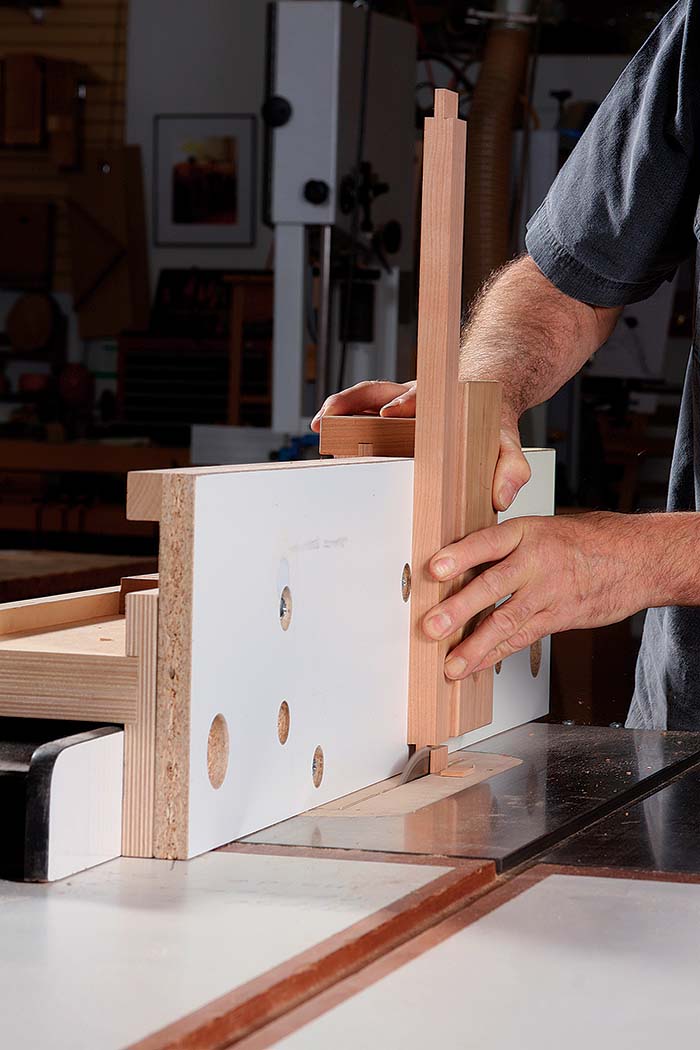 |
Build the base
Made of 3⁄4-in. plywood, two uprights and a bridge fit over the rip fence to serve as an anchor for a variety of special-purpose fences.

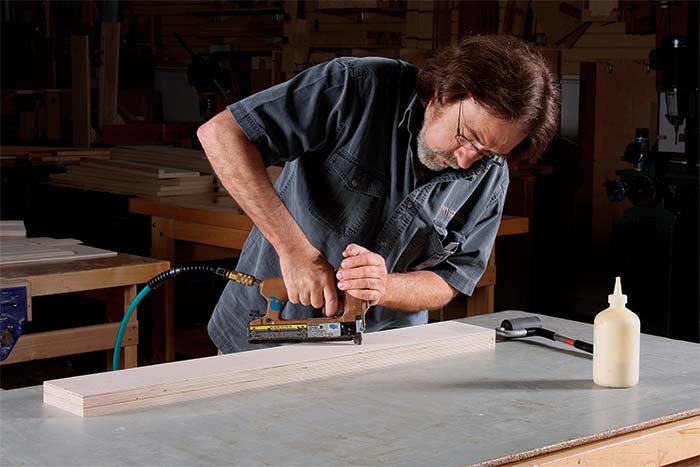 |
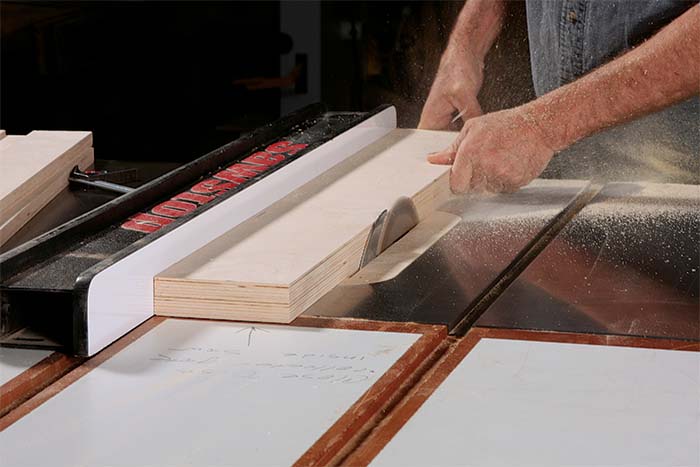 |
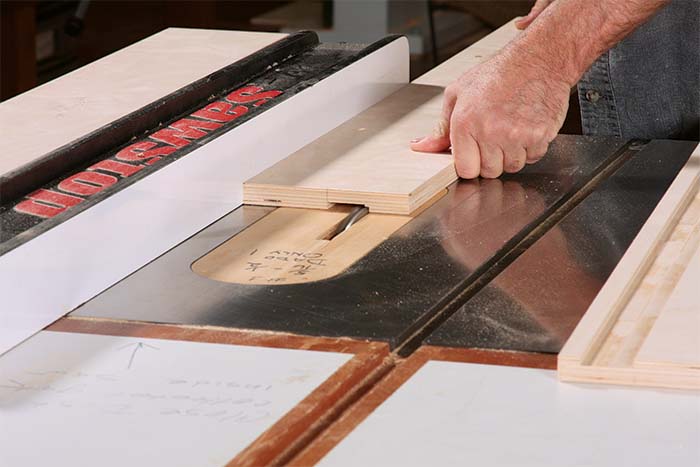
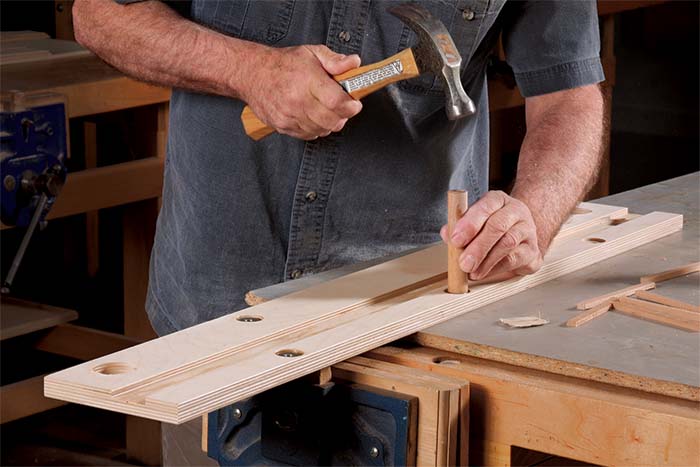 |
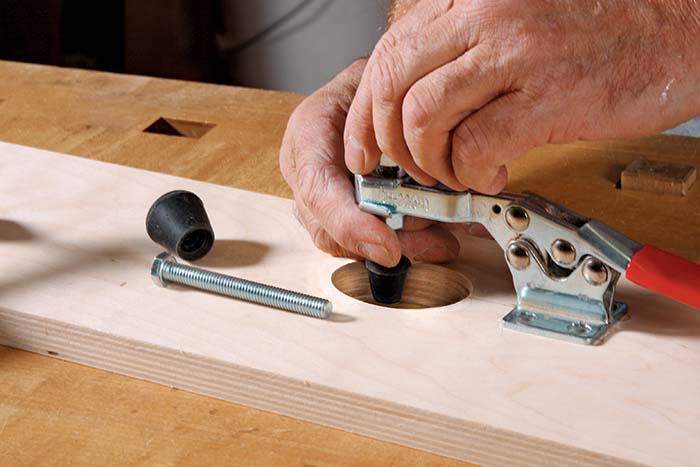 |
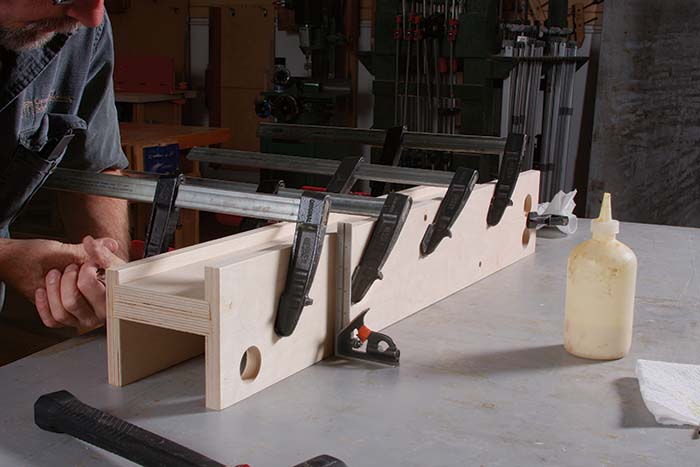
Make a few rabbeting fences
Burying a dado cutter in a sacrificial MDF fence lets you easily adjust the width of any dado or groove you are cutting.

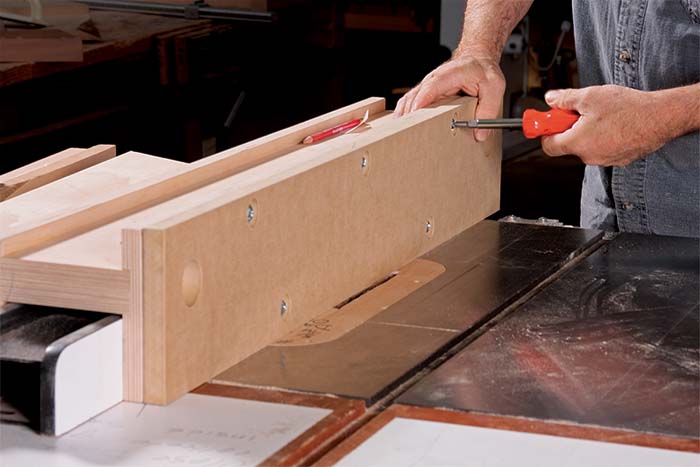
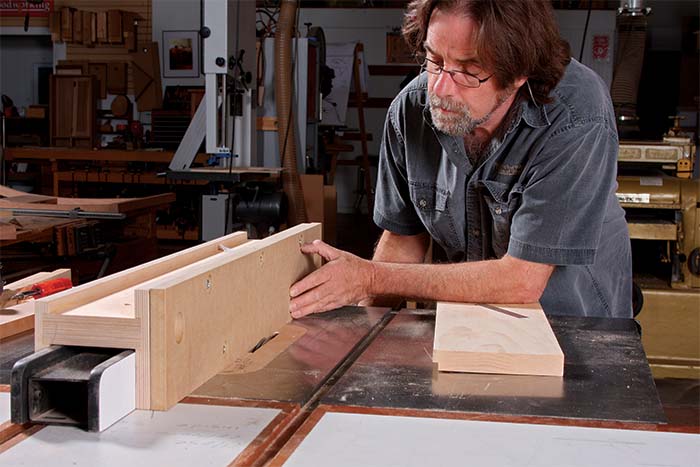 |
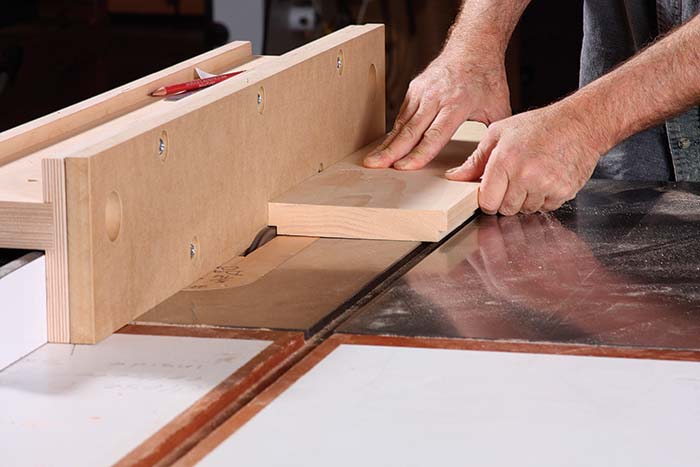 |
Tall fence is dual purpose
 |
 |
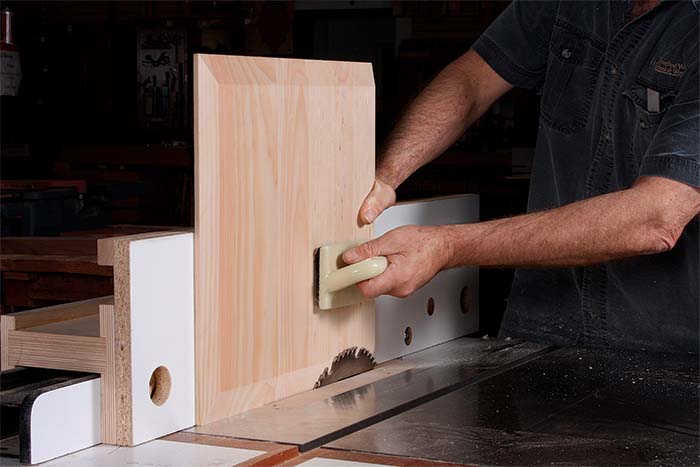
Tenoning jig
This push block wraps around the fence’s top runner, keeping the narrow workpiece perfectly vertical as you slide it forward.


For the full article, download the PDF below.
Fine Woodworking Recommended Products

Olfa Knife

Festool Cleantec CT 26 E HEPA Dust Extractor

Stanley Powerlock 16-ft. tape measure








Comments
Very good article. I'm making this but I'm wondering what the two outside holes are for that are close to the large hanging holes. They don't appear to have the threaded inserts but should I put them in there for some other purpose?
From what I understand, I built this a few months ago...The outer holes are for hanging purposes when you're not using it.
I am building this as well. is it five threaded holes or seven? the drawings show seven but the video and other drawings only show five. But the tall melamine fence has seven.. anyone know? thanks
rjherald
I'll reach out to Bob, but I doubt he remembers, or still has this particular fence still. Also, it doesn't really matter as long as the fence is secured.
Were the previous comments ever addressed? I understand that it must be difficult to go back to an old issue and try to figure out what was going on. Nevertheless, it would be appreciated if Fine Woodworking would at least act as if they take seriously apparent inconsistencies with dimensions of drawings provided in their magazine. It is frustrating to be treated as if questions and comments such as these are mere annoyances to the editors and authors to be treated with disdain.
I'm also trying to build this fence and at lease three notations in the drawing on page 58 of the article are not consistent.
1. The upper part of the drawing says that there should be 9 holes, but only 7 are shown. That appears to be a typographical error: I don't see 9 holes in any other drawing or photograph.
2. In the bottom part of the drawing, as user-6151007 noted, there are two small holes which are not described or depicted elsewhere in the article.
3. Based on my calculations, the 1-in. dimension from the bottom of the front upright to the center of the large holes cannot be correct, as the diameter of the large holes appears to be 1-1/4 in (see p. 60). However, if the 1-in. dimension were to be referring to the location of the bottom of the hole, then all the other dimensions work out. A total height of 5-1/2 in. is obtained from 3-1/4 in. to the top of the large hole plus 1-1/4 in. diameter for the hole, and 1 in. from the bottom of the front upright.
“[Deleted]”
What an awesome setup for the rip fence. I've been looking for the perfect one and this seems to cover everything, perfect. New to FW as I had to buy in to get the plans and article. However, seeing everything a subscriber has access to it seems invaluable. Back to this fence, in building it and being back and forth to this article, being almost done with it I finally made it down to the comment sections which I had all the same questions, some driving me a bit crazy as like most I want to follow directions exactly and build it right. So my 2 cents, 7 mounting holes with T-nuts is what's shown and is enough for mounting attachments, it does say 9 but the "wee hole" just outside the hanging hole does not have any explanation nor is it ever pictured with a T-nut in it so I didn't put that hole in and can't see a reason for it. But we figure this stuff out as we go, isn't it part of the hobby, and no one is perfect. Don't get mad at the editors or the guy who designed it, just figure it out and move on, or ask on here. But one last comment I was hoping not to see much of in theses areas of one woodworker helping another is the condescending attitude of pre madonnas who can never be wrong or understand how anyone can, and always have to let them know it, "dps13" So, For posterity and because I find the projection of misunderstanding as another's PERFECTION irksome, let's help each other and be nice. It's a much better way for all. My best to all.
Log in or create an account to post a comment.
Sign up Log in